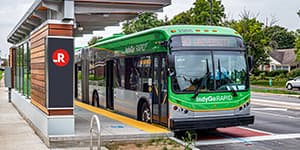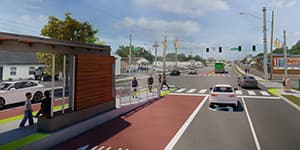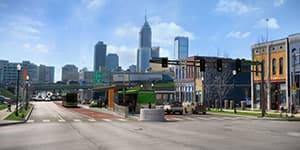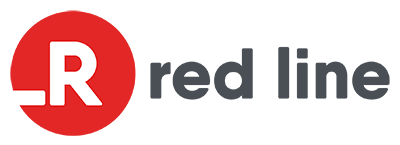INDIANAPOLIS – On Wednesday, Aug. 24, during IndyGo’s August Board Meeting, the Board of Directors discussed the status of the agency’s upcoming Blue Line bus rapid transit (BRT) route.
IndyGo staff informed the board they need more time to evaluate the current design of the Blue Line due to increased pricing, inflation and change in stormwater requirements. The original cost estimate for the project in 2019, pre-COVID, when the Blue Line was at 30% design, was $220 million. The latest cost estimates for the project are more than $500 million. The significant price increase is due to inflation and a change in design standards and costs for drainage infrastructure.
The updated infrastructure designs to the Blue Line were adjusted to meet compliance standards by Citizens Energy Group (CEG) and the Indianapolis Department of Public Works (DPW). IndyGo is working with CEG and DPW to evaluate those requirements and the impact on the Blue Line.
“IndyGo is committed to completing a transit project along Washington Street that delivers more efficient, accessible and rapid service to the community and works to implement the Marion County Transit Plan,” said IndyGo President and CEO Inez Evans. “Taking some time to review alternatives before moving forward allows us to present the best project for the community and continue to be good stewards of taxpayer dollars.”
IndyGo will continue to work with partners and all parties involved to determine the best alternatives available to complete a rapid transit project.
For more information, please read the following FAQs:
What is the status of the Blue Line?
IndyGo staff informed the board that they need more time to evaluate the current design of the Blue Line due to increased pricing, inflation and change in stormwater requirements.
Why is the cost so different from the original estimates?
The cost estimates we were working from were developed at the 30% design submittal, which was in 2019, pre-COVID. The updated numbers were calculated based on the 60% design, and considered recent IndyGo, DPW and INDOT bid tabulations to get the most accurate costs for the current economic situation. The highest cost components of the new Blue Line are electric buses, drainage and inflation. The bus cost estimate is around $128 million for 55 battery electric buses. The Blue Line is showing an estimated 42% of the project cost is drainage infrastructure, increased significantly from the 30% design cost because of changes in design standards and assumptions. Inflation adds an additional $60 million to the current cost. Current cost estimates are totaling more than $500 million which is more than doubled.
How do Blue Line stormwater infrastructure costs compare to Purple Line stormwater cost?
Purple Line:
15 miles
18% of construction cost to address drainage
Blue Line:
24 miles
42% of construction cost to address drainage
What changed in the stormwater requirements that impacted the cost?
The updated designs to Blue Line were adjusted to meet compliance standards. IndyGo is working with CEG and DPW to evaluate those requirements and the impact on the Blue Line.
How did IndyGo come to this decision?
In July, IndyGo hosted a value engineering workshop with some of the industry’s top professionals in transit, infrastructure, and construction management. Those professionals included representatives from transit agencies in Jacksonville, Denver, Los Angeles and the Federal Transportation Administration. The results of that evaluation offered some recommendations we need to further analyze the best way to move forward.
Will IndyGo lose the grant if they do not proceed with design?
This project is so important to the future network that we have remained in close contact with our partners at the FTA. We’re sensitive to the need to put forth a Blue Line project that is highly competitive. The analysis we are planning will help us prepare our update for the grant submission to the FTA. If this change in definition for the project were to have an impact on our scoring, we’ll know what we need to address and will have the time to do so before submitting our final grant request.
What is next?
Next steps include taking some time to work with all our design partners, the City of Indianapolis, CEG and the community to determine the best alternatives are available to complete a rapid transit project.
Didn’t IndyGo just get $33 million from the FTA?
Yes, but the grant was specific to fund building a new garage at our East Campus to accommodate the additional buses we will need for the Purple Line and any future rapid transit projects.
For additional questions, please contact Carrie Black, IndyGo director of communications at carrie.black@indygo.net or 317-664-1951.
###





